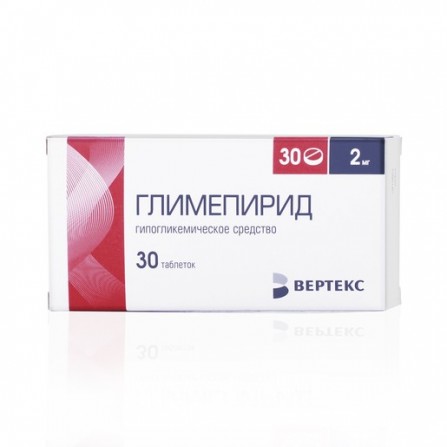Glimepiride pills 2 mg 30 pcs
Condition: New product
1000 Items
Rating:
Be the first to write a review!

More info
Active ingredients
Glimepiride
Release form
Pills
Composition
1 tablet contains: Active ingredient: 2 mg of glimepiride. Auxiliary substances: lactose monohydrate 159 mg, microcrystalline cellulose 24 mg, sodium carboxymethyl starch 10 mg, povidone 2 mg, polysorbate 80 1 mg, magnesium stearate 2 mg.
Pharmacological effect
Oral hypoglycemic agent, sulfonylurea derivative. Stimulates insulin secretion by pancreatic β-cells, increases insulin release. Increases the sensitivity of peripheral tissues to insulin.
Pharmacokinetics
With repeated ingestion in a dose of 4 mg / day, Cmax in serum is reached after about 2.5 hours and is 309 ng / ml; there is a linear relationship between dose and Cmax, as well as between dose and AUC. Food intake does not have a significant effect on absorption. The Vd is about 8.8 liters. Plasma protein binding is more than 99%. Clearance is about 48 ml / min. It is metabolized. Hydroxylated and carboxylated glimepiride metabolites are formed, apparently due to metabolism in the liver and are found in the urine and in the feces. T1 / 2 is 5-8 hours. After taking glimepiride in high doses, T1 / 2 increases. After a single oral dose of glimepiride labeled with radioactivity, 58% of the radioactivity was detected in the urine and 35% in the feces. Unchanged active substance was not detected in urine. T1 / 2 hydroxylated and carboxylated glimepiride metabolites were, respectively, about 3-6 hours and 5-6 hours. Patients with impaired renal function (with low CC) tended to increase the clearance of glimepiride and decrease its average concentrations in serum. Thus, in this category of patients there is no additional risk of glimepiride cumulation.
Indications
Type 2 diabetes mellitus (insulin-independent) in the case of failure of diet therapy and exercise.
Contraindications
Type 1 diabetes mellitus (insulin-dependent), ketoacidosis, precoma, coma, liver failure, renal failure (including patients on hemodialysis), pregnancy, lactation, hypersensitivity to glimepiride, other sulfonylurea derivatives and sulfanilamides.
Precautionary measures
It is used with caution in patients with concomitant diseases of the endocrine system that affect carbohydrate metabolism (including dysfunction of the thyroid gland, adeno-pituitary or adrenocortical insufficiency).
Use during pregnancy and lactation
Contraindicated for use in pregnancy. In the case of a planned pregnancy or pregnancy, a woman should be transferred to insulin. During lactation, a woman should be transferred to insulin. Experimental studies have established that glimepiride is excreted in breast milk.
Dosage and administration
The initial and maintenance dose is set individually based on the results of regular monitoring of the level of glucose in the blood and in the urine. The initial dose is 1 mg 1 time / day. If necessary, the daily dose can be gradually increased (by 1 mg over 1–2 weeks) to 4–6 mg. The maximum dose is 8 mg / day.
Side effects
On the part of metabolism: hypoglycemia, hyponatremia. On the part of the digestive system: nausea, vomiting, discomfort in the epigastrium, abdominal pain, diarrhea, increased activity of hepatic transaminases, cholestasis, jaundice, hepatitis (up to the development of liver failure). hematopoiesis: thrombocytopenia, leukopenia, erythropenia, granulocytopenia, agranulocytosis, pancytopenia, hemolytic anemia. On the part of the organ of vision: transient visual disturbances. Allergic reactions: itching, urticaria, skin rash; rarely - dyspnea, fall in blood pressure, anaphylactic shock, allergic vasculitis, photosensitivity.
Overdose
Symptoms: hypoglycemia, up to the development of coma. Treatment: IV bolus injection of 50% glucose solution, then infusion of 10% glucose solution. If the patient is conscious, a sweet, hot drink is recommended. Constant monitoring and maintenance of vital functions, the concentration of glucose in the blood (at 5.5 mmol / l) for at least 24–48 h (repeated episodes of hypoglycemia) are necessary.
Interaction with other drugs
Strengthening the hypoglycemic effect of glimepiride is possible with simultaneous use with insulin or other hypoglycemic drugs, ACE inhibitors, allopurinol,anabolic steroids , probenecid, quinolones, salicylates, sulfinpyrazone, sulfonamides, tetracyclines. Easing of the hypoglycemic action of glimepiride is possible while with acetazolamide, barbiturates, corticosteroids, diazoxide, diuretics, epinephrine (adrenaline) and other sympathomimetics, glucagon, laxatives (after long-term use), nicotinic acid (in high doses), estrogen and progestogen, phenothiazine, phenotomine, phenomidine, pyrotoinosine, injectable, high-dose) glands. When used simultaneously, histamine H2 receptor blockers, clonidine and reserpine, can both potentiate and decrease the hypoglycemic effect of glimepiride. Against the background of glyme Epyrid may enhance or weaken the action of coumarin derivatives. Ethanol may enhance or weaken the hypoglycemic action of glimepiride.
special instructions
In stressful situations (with injury, surgery, infectious diseases, accompanied by fever), it may be necessary to temporarily transfer the patient to insulin. It should be noted that the symptoms of hypoglycemia may be smoothed out or be completely absent in elderly patients, patients with NDC or receiving simultaneous beta treatment -adrenoblockers, clonidine, reserpine, guanethidine, or other sympatholytics. When compensation for diabetes is achieved, insulin sensitivity is increased; therefore, the need for glimepiride may decrease during the treatment process. In order to avoid the development of hypoglycemia, it is necessary to reduce the dose in time or cancel glimepiride. Dose adjustment should also be carried out when the patient's body weight changes or when their lifestyle changes, or when other factors appear that contribute to the development of hypo- or hyperglycemia. When switching to glimepiride from another drug, the degree and duration of the effect of the previous hypoglycemic agent should be taken into account.It may be necessary to temporarily discontinue treatment in order to avoid an additive effect. During the first weeks of treatment, the risk of hypoglycemia may increase, which requires particularly strict monitoring of the patient. Factors contributing to the development of hypoglycemia include: irregular, malnutrition; changes in the usual diet; drinking alcohol, especially when combined with skipping meals; change in the usual regime of physical activity; simultaneous use of other drugs. Hypoglycemia can be quickly stopped by taking carbohydrates immediately. During the period of treatment, regular monitoring of blood glucose and urine levels, as well as glycated hemoglobin concentrations, is necessary. attention and speed of psychomotor reactions.




